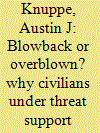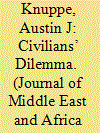|
|
|
Sort Order |
|
|
|
Items / Page
|
|
|
|
|
|
|
| Srl | Item |
| 1 |
ID:
186861


|
|
|
|
|
| Summary/Abstract |
How do military tactics shape civilian support for foreign intervention? Critics contend that invasive tactics undermine popular support by alienating the civilian population. Counterexamples suggest that civilians will support invasive tactics when foreign counterinsurgents are willing and able to mitigate a proximate threat. I reconcile these divergent findings by arguing that civilian support is a function of threat perception based on three interacting heuristics: social identity, combatant targeting, and territorial control. To evaluate my theory, I enumerate a survey among Iraqi residents in Baghdad during the anti-ISIS campaign. Respondents preferred more invasive tactics when foreign counterinsurgents assisted the most effective local members of the anti-ISIS coalition. Across sectarian divides, however, respondents uniformly opposed the deployment of foreign troops. These findings suggest that in regime-controlled communities, civilians will support counterinsurgents who are invasive enough to mitigate insurgent threats, but not too invasive as to undermine local autonomy.
|
|
|
|
|
|
|
|
|
|
|
|
|
|
|
|
| 2 |
ID:
191892


|
|
|
|
|
| Summary/Abstract |
How did Iraq’s ethnic and religious minorities survive the Islamic State (ad-Dawlah al-Islāmiyah, IS) occupation of Ninewa Governorate? Existing accounts of wartime survival either essentialize social identity or ignore it altogether by reducing survival to cost-benefit calculations or political opportunism. Against the conventional wisdom, this article argues that individuals survive conflict by drawing on repertoires – consisting of practices, tools, organized routines, symbols, and rhetorical strategies – to navigate violent situations. Distinct from deliberate calculations or rational strategies, repertoires are creative, flexible, and often contradictory. The author examines Iraqis’ reliance on survival repertoires through a mixed-methods research design of observational data and fieldwork. This study begins by analyzing migration patterns recorded in the United Nation’s Displacement Tracking Matrix. To understand how Iraqis who remained survived the conflict, this work draws on original interviews with Iraqi peacebuilders from minority communities. While most minorities fled during the IS offensive of June 2014, those who remained pursued various forms of cooperation, contention, and neutrality. This research finds that those who remained survived the conflict by mobilizing self-defense groups and by their coordination with members of the anti-IS coalition. Opportunistic collaboration with IS insurgents during the initial stages of the occupation was less common. In areas where the Iraqi Security Forces (al-Quwāt al-Maslahah al-ʿIrāqiyya, ISF) or Peshmerga were absent, residents mobilized community militias unaligned from Baghdād or Arbīl. The findings of this research provide insights for scholars and practitioners interested in peacebuilding, transitional justice, and post-conflict reconstruction in fragile states.
|
|
|
|
|
|
|
|
|
|
|
|
|
|
|
|
|
|
|
|
|